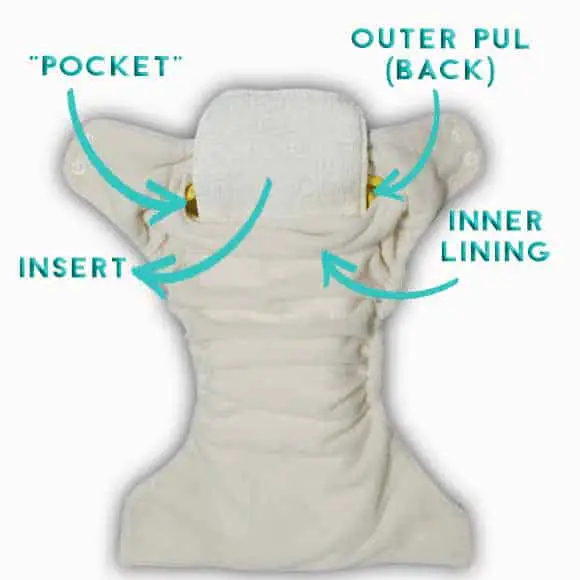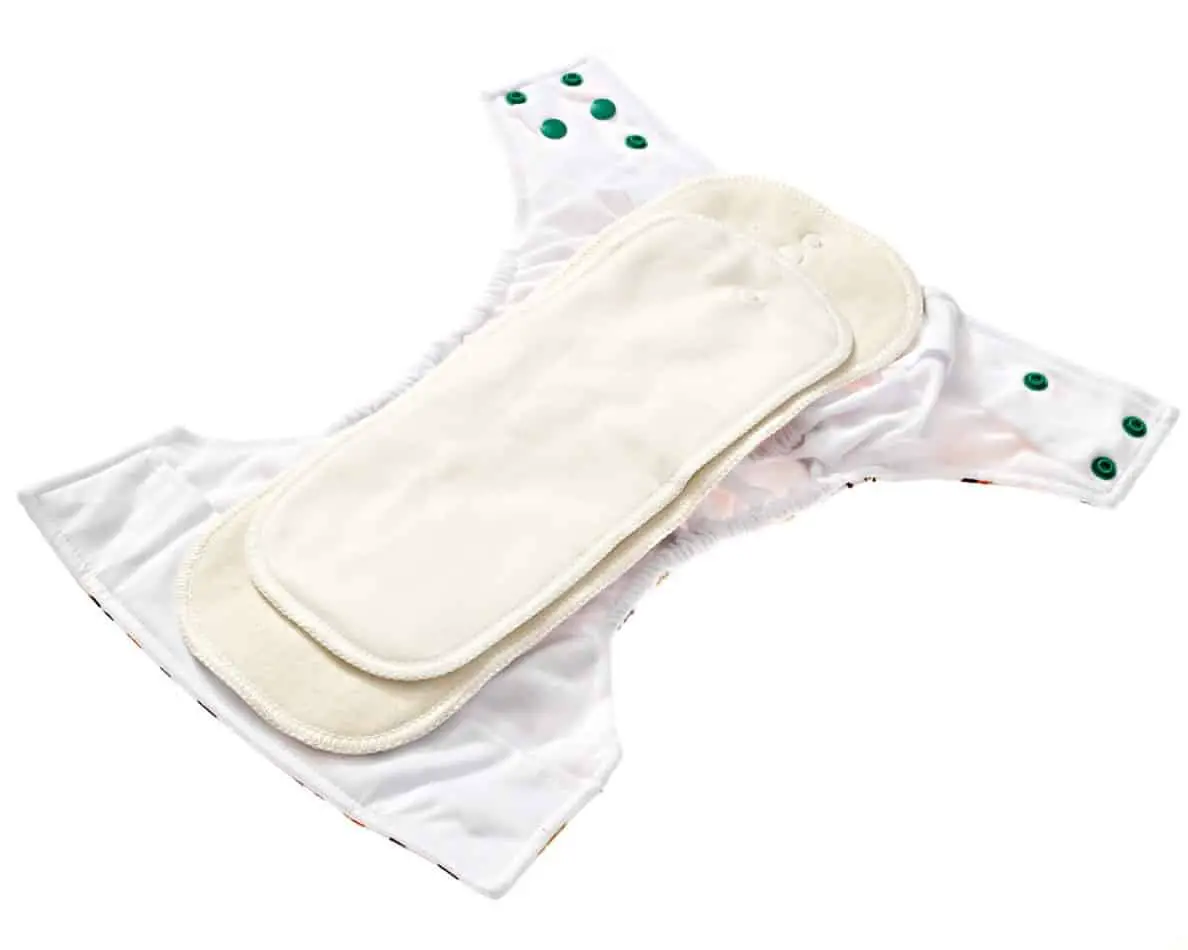Pocket diapers are everywhere. Most (though not all) cloth diaper brands have a pocket diaper available and there are several brands that only sell pocket diapers (also called pockets for short).
So what is a pocket cloth diaper? A pocket diaper is a cloth diaper with a cover that has a “pocket” built into the inside. This ‘pocket’ is actually the gap that’s made between the outer, waterproof shell and an inner “stay dry” polyester lining. Inserts or prefolds are inserted inside the pocket to hold them in place and make the diaper easier to put on.
Here’s a photo to help you get the idea if you’re new to these:

What Materials Are Used in Pocket Diapers?
Just like regular, non-pocket diaper covers, pocket diaper covers use water-resistant Polyurethane laminate (PUL) to keep all the wetness in. As mentioned, a lining is sewn onto the edges of this PUL to act as a “stay-dry” layer and to keep the inserts in place. This lining is most often made from microfleece or microsuede.
How Do Pocket Cloth Diapers Work?
Pocket diapers may seem a bit confusing at first, but they are actually very easy once you take one for a test drive.
To use a pocket diaper, simply choose some inserts, stuff them into the ‘pocket” and then put the diaper on your baby just like you would a disposable diaper.
Once the diaper is wet or soiled, remove it, and get it ready for washing. If baby isn’t exclusively breastfed (EBF), then this includes removing the solids from the diaper (more info on dealing with the poop is available here). And if your pocket diaper has only one opening, it also means removing the inserts before placing it in your dirty diaper storage pail or bag.
That’s it; wash and repeat.

Save Your Sanity and Avoid Diaper Smells and Rashes with This Easy-To-Follow Digital Handbook. This Ultimate Wash and Care Guide Will Give You the Step-By-Step Coaching Your Mom Group Can't Provide!
Are Pocket Diapers Any Good?
When you begin your search for cloth diapers, you’re going to find pocket diapers everywhere. They are a very popular option among cloth diaper users, especially beginners, because they are made by most cloth diaper brands in a variety of prints and the price tag is usually low (compared to many regular diaper covers).
But as with any diaper system (others include all-in-ones, all-in-twos, prefolds, fitteds, and flats), there are pros and cons. Here’s a list of pros and cons to consider when deciding if pocket diapers might be right for your diaper journey:
What are the Pros and Cons of Pocket Diapers?
Pros
- Faster Changes. Once the insert has been placed inside the pocket, the diaper is ready-to-go at change time, which makes diaper changes quick and easy.
- Daycare friendly. Already stuffed pocket diapers are ready to go at diaper changes to be used just like an all-in-one, and so they are perfect for child care providers, grandparents, and anyone not completely on-board yet with the whole cloth diaper thing. These diaper changers can put the diaper on and take it off after each use in one step, using them just as though they were disposables.
- Easier to Wash than AIO’s. Because the insert is removable from the pocket, the whole diaper washes more thoroughly and will dry faster than all-in-one diapers. With that said, they are more difficult to clean than prefolds or flats.
- Prints, prints, and more prints. Because pocket diapers are made by so many retailers, and because of their popularity, there is no shortage of cute prints and all shades of solid colors can be found. No matter what your style, you’ll find many diaper prints to match if you look at pocket diaper options.
Cons
- Stuffing. As mentioned, inserts must be placed inside the pocket diaper before use, and removed prior to washing (unless they have two openings). While we’re talking about seconds per diaper per wash, stuffing is often one of the biggest complaints from those using pocket diapers.
- Additional Work at Diaper Changes. Though many pocket diapers have two openings to allow the insert to be agitated out by the washing machine, some pockets don’t, and others use inserts that snap in place. When using those pocket diapers, inserts must be unattached and/or removed before washing. Removal of the inserts can be an unpleasant task.
- Slightly Expensive. Even though pockets can have lower price tags than some pocket-less covers, because the diaper cover must be changed with the diaper inserts at every diaper change, pocket diapers can be on the expensive side as you’ll need many more than with systems with wipable-covers. For more on covers vs. pocket covers, click here.
- Limited Pocket Space. Because the cover and inner layer of pocket diapers are usually cut to a similar size, pocket diapers can bulge and arch when stuffed when additional inserts are added. This can cause leaks as it can cause gaps around baby’s legs and waist.
How Many Inserts Go in a Pocket Diaper?
Usually, when a baby is still in the newborn phase (before about 3-5 months), you can get away with just one good insert. But after the 5 month mark, when baby is wetting less-often, but in bigger quantities, you can expect to need more than one insert per diaper change.
I have a whole post that goes into detail about how, and with what, to stuff a pocket diaper with here. In that article I talk about materials and absorbency to really help you stack up the perfect diaper for your little one, so do check that out when you can.
What to Look for In a Pocket Diaper
With so many pocket diaper brands, and such a different quality between them, I thought it might be helpful to point out some qualities that make one pocket diaper a bit better than another. So here’s a list of five things that make a pocket diaper worth the purchase:
- Double openings. Some pocket diapers have one opening between the inner lining and the PUL, while others have two (one at the front and one at the back). Those with two openings are actually a little bit better because you won’t need to “unstuff” them (remove the inserts) before washing them. Inserts need to be removed to get clean, and with two openings in the diaper, most washing machines are able to agitate the inserts out of the pocket for you.
- Natural fiber inserts (or at least not thin microfiber). Unfortunately, most cheap pocket diapers on the market come with thin microfiber or charcoal bamboo (which often doesn’t contain any bamboo, click here for more on that) inserts. These inserts rarely work for long and are prone to leaks. A good quality pocket diaper will come with good quality inserts. The best performing inserts are made from natural fibers like cotton, hemp and/or bamboo.
Again, you can click here to learn more about pocket diaper inserts. - Roomy pockets. As mentioned above, pocket diapers do restrict how much absorbency you can fit into them. Pocket diapers can bulge and compress your inserts when stuffed when additional inserts are added. This can cause leaks in a number of ways. Looking for pockets with lots of room in the pocket can help avoid those leaking issues, and can also make stuffing them easier.
- Durable PUL. This one is a little harder to pin-point, but in general a good, durable PUL is both thick feeling and soft, not stiff and plastic-like. When in doubt, you can always find out how well the PUL lasts by looking for reviews and checking into the brand’s reputation, which is the next point.
- Good reputation. New “brands” of direct-from-China pocket diapers, also called “China Cheapies” (referring to the manufacturing location and lack of quality standards in place for manufacturers in China) pop up all the time.
You can read our review of one of them, MG Baby Cloth Diapers, here to get an idea of how bad they are. Suffice it to say here that they’re not the same quality as North American-sewn diapers like Thirsties and AppleCheeks, or longstanding Chinese brands like AlvaBaby. When it comes to pocket diapers, reputation is often the best indicator of quality. Always look for or ask your cloth diaper community for reviews before making a purchase from an unknown brand of pocket diapers.
Best Pocket Diapers for Beginners
Bungies is a cloth diaper subscription service (though you can purchase single diapers as well). Their pocket diapers are both reasonably priced and premium quality coming with both a three-layer hemp and a four-layer bamboo insert right out of the box! We can't say enough about these pocket diapers!
USE COUPON CODE "CDFB15" FOR 15% OFF YOUR FIRST PURCHASE
April Duffy
April is the founder of Cloth Diapers for Beginners and author of The Cloth Diaper Wash & Care Handbook. Since 2015, April has helped well over 75,000 parents and caregivers cloth diaper their children through this website, her book, her YouTube Channel, and the Cloth Diapers for Beginners Facebook Group.
Save Your Sanity and Avoid Diaper Smells and Rashes with This Easy-To-Follow Digital Handbook. This Ultimate Wash and Care Guide Will Give You the Step-By-Step Coaching Your Mom Group Can't Provide!

